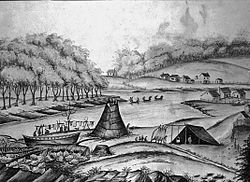Louis Campau
[1][3] The Sophie de Marsac Campau Grand Rapids Chapter of the Daughters of the American Revolution was created in her memory and in so doing "perpetuated the name of a woman of rare grace and character who was held in high esteem by the early pioneers.
[2] This Treaty was made between Gen. Lewis Cass and Native American tribes of the Great Lakes region (principally the Ojibwe, but also the Odawa (Ottawa) and Potawatomi) of Michigan.
Native Americans ceded more than six million acres (24,000 km2) in the central portion of the Lower Peninsula of Michigan.
[5] In 1826, Campau built his cabin, trading post, and blacksmith shop on the east bank of the Grand River near the rapids, where he found that the area Native Americans were "friendly and peaceable".
Campau bought 72 acres around his trading post and near the Baptist mission for $90 on September 19 of that year.
[2] One year later, government surveyor Lucius Lyon purchased land north of Campau's property.
Although Lyon was able to obtain land near the river and created Canal Street to meet up with Campau's Monroe Avenue, eventually the Kent Company was “forced out of existence”.
[10] The Treaty of Detroit with the federal government meant that one of the signers, Cobmoosa, would relocate with his tribe from the Grand Rapids area to Oceana County, Michigan.




